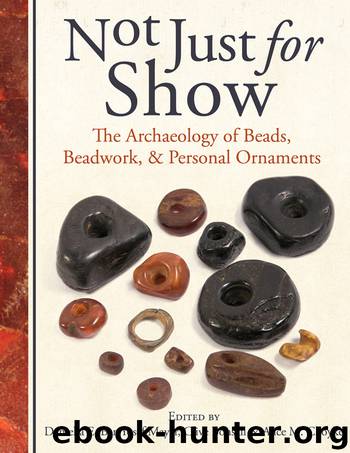Not Just for Show by Bar-Yosef Mayer Daniella; Bonsall Clive; Choyke Alice M

Author:Bar-Yosef Mayer, Daniella; Bonsall, Clive; Choyke, Alice M.
Language: eng
Format: epub
ISBN: 5097121
Publisher: Oxbow Books, Limited
Published: 2017-04-14T16:00:00+00:00
Mortar Riddle Archaeology
Mortar Riddle (35HA2627) is an Archaic 1,890–100 cal BP site located in North America’s northern Great Basin at 1,561 m (5,120 ft) on Steens Mountain. The Late Archaic period in the northern Great Basin is characterized by the addition of the bow and arrow to the hunter-gatherer tool kit, variability in group mobility, the addition of rock-borders to wickiup houses, and material culture typically associated with the Plains, Plateau, and Coastal regions. The site is well within the Northern Paiute cultural area (Steward 1938; Fowler and Liljeblad 1986) and ethnographic records (Kelly 1932; Spier 1930; Whiting 1954) indicate at least three different groups – the Surprise Valley Paiute, the Klamath and the Harney Valley Paiute – visited Steens Mountain prior to and around the time of Euro-American incursion. Steens Mountain is threaded with river systems, most of which drain into the relatively well-studied Harney Basin (Fagan 1974; Musil 1992; Oetting 1992; O’Grady 2006; Wigand 1985). How the archaeology of this mountain range, a so-called “hinterland,” is connected to the broader region requires synthesis (Jenkins et al. 2010:25).
The Mortar Riddle site is on a southeast facing river terrace from which site occupants had prime access to a wide variety of floral and faunal resources. Fresh water, the limiting resource within the broader high desert environment, is a mere 100 m away in the perennially flowing Little Blitzen River. The site’s 10,000 sq m surface includes mounded earth features densely scattered with flaked and ground stone tools. Ground stone mortars visible on the site’s surface total 65 in number.
Approximately 20 sq m of sediment was excavated from the site’s earthen mounds over the course of five field seasons. Of the 19 beads considered here, 16 were recovered from the largest mound in a hard packed, house floor lens (Fig. 6.2). One additional bead was recovered from a midden and hearth feature. Wood charcoal associated with the house floor lens produced a radiocarbon age of 920 ± 40 BP (Beta-239165; wood charcoal) and a 2σ calibrated age range of 930–740 cal BP. We exposed a portion of the hard packed, house floor lens in the North Block excavation unit. The floor includes a large hearth feature, stone alignments suggesting wall supports, ground stone mortars, numerous hand stones and hundreds of flaked stone tools, as well as beads and bone game pieces. It is useful to consider four zones of the floor; the hearth area, large ground stone mortars aggregated along the southern wall, the northern rock wall support feature, and the western personal/sleeping area. I argue the last mentioned living space is indicated by the lack of large site-furniture such as large rocks or ground stone artifacts and the presence of a smaller interior hearth. This house floor assemblage is the focus of this paper. Another midden and hearth feature, located 15 m south of the house floor, produced a relatively poorly organized cultural matrix containing a hearth, surrounded by burned and gnawed bone, chipped and ground stone artifacts, one bone game piece and a stone bead (Mueller 2007).
Download
This site does not store any files on its server. We only index and link to content provided by other sites. Please contact the content providers to delete copyright contents if any and email us, we'll remove relevant links or contents immediately.
How to Be a Bawse: A Guide to Conquering Life by Lilly Singh(6714)
Spare by Prince Harry The Duke of Sussex(4236)
Millionaire: The Philanderer, Gambler, and Duelist Who Invented Modern Finance by Janet Gleeson(3585)
Harry Potter 02 & The Chamber Of Secrets (Illustrated) by J.K. Rowling(3298)
Urban Outlaw by Magnus Walker(2955)
The Heroin Diaries by Nikki Sixx(2946)
Never by Ken Follett(2922)
Japanese Design by Patricia J. Graham(2569)
The Club by A.L. Brooks(2389)
Machine Learning at Scale with H2O by Gregory Keys | David Whiting(2333)
The Man Who Died Twice by Richard Osman(2317)
Stacked Decks by The Rotenberg Collection(2289)
Harry Potter and the Deathly Hallows (7) by J.K. Rowling(2241)
Fairy Tale by Stephen King(2107)
Harry Potter and the Prisoner of Azkaban (Book 3) by J. K. Rowling(2101)
Will by Will Smith(2083)
Churchill by Paul Johnson(2020)
The Chimp Paradox by Peters Dr Steve(1875)
The 7 Habits of Highly Effective People: Powerful Lessons in Personal Change (25th Anniversary Edition) by Covey Stephen R(1845)
